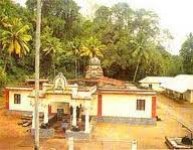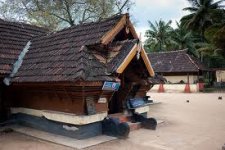

The main Pratishta of Sabarimala is Dharma Sasthavu, holding Chinmudra in meditating state as “Parabramha sworoopan”. The temple is situated in Sabaripeedam near the bank of Holy Pampa River. Upa devans are Ganapathi (Kannimoola ganapathy) Naga gods, Valiya kadutha swamy, Kochu kadutha swamy, Mala daivangal, Nava grahas, Karuppu swamy and Karuppai Amma. Malikapuram has importance almost in par with Sri Ayyappa. The temple in the poonkavanam of Sri Ayyappa is the classic proclamation of Adwaitha. Sabarimala enlightens the truth of “Ekavdhiteeyam Bramma” where the God, devotee, neighbor and all become one Ayyappa, the epitome of unity. The unique feature of the temple is the “Vavar nada” a worship point highlighting the social and secular texture of this holy land. Sri Ayyappa is a “brammachari” and it calls for special customs and practice. All pilgrims doing Darshan after 41 days Vratham is considered as Ayyappa or malikapuram.
Sabarimala temple complex have Pampa Ganapathi temple, Nilakal Mahadeva temple and Palliyara Bhagavathi temple. The Nilakal Mahadeva temple and Palliyara Bhagavathi temple is as old as the Sastha temple and the gods are worshipped as the parents of Lord Ayyappa. Ganapathi temple at Pampa has Pampa Maha Ganapathi and Athi Ganapathi, (old ganapathy) sreekovil where the idol from the first Ganapathy temple is worshiped. Sabari peedam blessed with the footprint of Srirama has a temple of Sri Rama and Hanuman also. Millions of devotees making pilgrimage to Sabarimala worship in all the temples
Sabarimala Dharmasasthav temple is believed to be consecrated by Parasurama Maharshi. According to legends, Parasurama Maharshi hurled his axe into sea and water is said to have withdrawn till the spot where it fell. After creating this land, Parasurama Maharshi built Dharmasasthav temple in the high ranges of the forest to protect the land. The consecration of Dharmasasthav deity was done on Makarasamkrama day. Devendran and Narada Muni blessed the occasion by lighting the golden flame in Ponnambalamedu. The spirit of Lord Ayyappa merged with Dharmasasthav deity to protect the land. The temple was rebuitl and maintained by King of Pandalam from the time of the incarnation of Dharmasasthav as Sri Ayyappan. When Travancore was formed, the powers and properties of Pandalam kingdom moved to Travancore and the temple is now administered by Travancore Devaswom Board.

Achankovil Shastha Temple, or the Dharmasastha Temple, is one among the five important temples dedicated to Lord Ayyappa in Kerala. Lord Ayyappa leads the Grihastha Ashrama life here – he is depicted as a family man or leads married life here. He is depicted along with his two wives – Purna and Pushkala. It is believed that the idol here was installed by Lord Parashurama.
The Achankovil Sastha Temple is famous for curing poisonous snake bites. The left hand of the idol of Ayyappa at Achankovil Shastha Temple always holds ‘Chandan’ (sandalwood paste) and Thirtha (holy water). The Chandan and Thirtha are considered to have medicinal properties to cure snake bites.The temple complex also contains other deities associated with the Ayyappa legend. The festivals and rituals held here have strong Tamil roots During the Sabarimala pilgrimage, devotees also visit this temple to offer their prayers. It is believed that the idol of this temple was consecrated by Sage Parasurama. On both sides of the idol, Poorna and Pushkala, the consorts of Lord Sastha are also installed.The most important festival here is celebrated from the first to tenth day of Malayalam month Dhanu (December – January).

Situated on a forest range on the Thiruvananthapuram – Shenkottai road, Kulathupuzha is known for the Sastha temple. The Vishu Mahotsavam in April/May is the most important festival. There are frequent buses from Kollam to Kulathupuzha. The Thenmala railway station is just 10 km from here.The Sastha Temple at Kulathupuzha is very ancient. The idol at Kulathupuzha is called ‘Manikandan’. It is believed that the Temple was constructed by the Raja of Pandalam. But the idol was discovered by a Brahmin from Kottarakkara after several years and he started pooja there. The King of Kottarakkara heard about this and constructed the present temple. Feeding to the fishes in the nearby river is an important ‘vazhipadu’ in the Temple.

The 18 steps of sabarimala is believed to be the symbolic representation of the life,spirit and environment.It is believed to be based on following facts.
The padi pooja,which is one of the most sacred rites of Sabarimala performed at all the steps.Piligrims with Erumudikettu are allowed to step in to thirumuttam through the 18 steps.